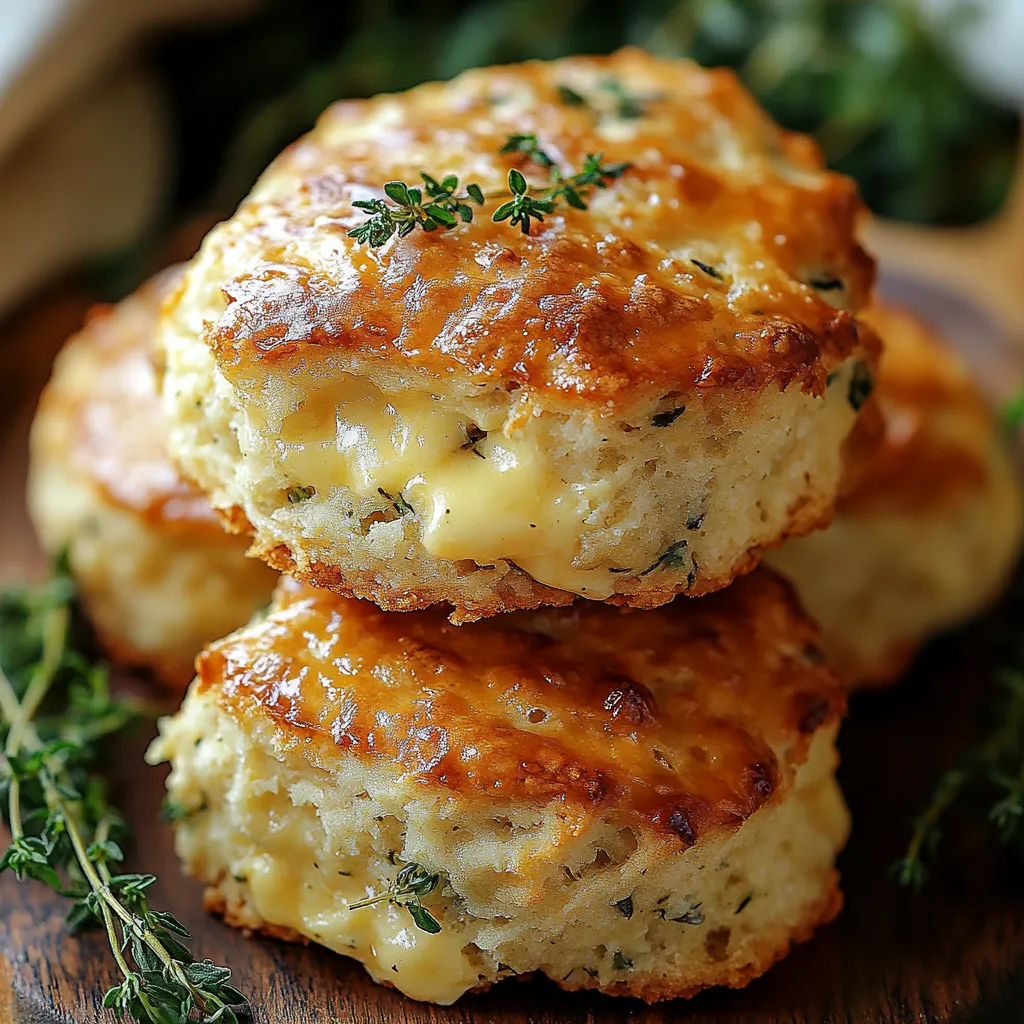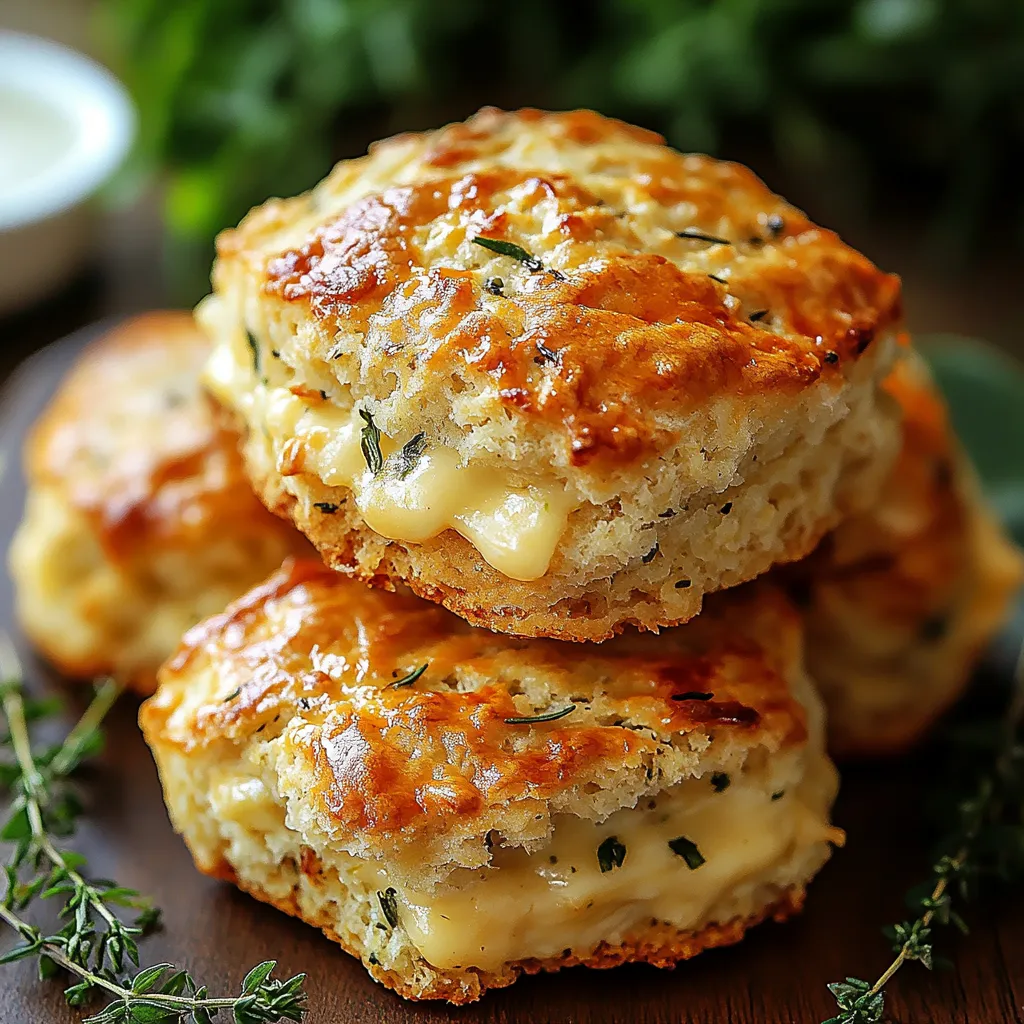 Pin it
Pin it
These savory herb and cheese scones bring together a flaky crumb, sharp cheddar, and an aromatic blend of rosemary and thyme for a memorable baked treat that always impresses. Perfect for brunch, dinner parties, or just a cozy afternoon with a cup of tea, these scones are my go-to recipe whenever I want to share homemade comfort.
I first made these on a blustery weekend when my garden was overflowing with fresh thyme and rosemary. Everyone in my family asked for seconds—they disappear fast every time I bake them.
Ingredients
- All-purpose flour: Gives the basic structure and a tender crumb. Be sure to fluff and spoon the flour for accuracy.
- Baking powder: Provides a strong rise and that classic scone lightness. Freshness counts for full lift, so check that it has not expired.
- Baking soda: Helps with browning and works with buttermilk’s acidity. Look for fine soda that clumps less.
- Salt: Wakes up and balances all the flavors. Use fine sea salt for even seasoning.
- Black pepper: Adds warmth and subtle spice. Go with freshly cracked pepper for extra pop.
- Fresh rosemary and thyme: Deliver a fragrant herbal punch. Choose sprigs that look perky and use only the tender leafy tips.
- Sharp cheddar cheese: Adds savory richness and melts for lovely pockets. Buy a block and shred it yourself for best melt and flavor.
- Cold unsalted butter: Makes the layers flaky. Cube it straight from the fridge and try not to handle much so it stays cold.
- Buttermilk: Creates an ultra-tender and tangy crumb. Shake well before measuring for uniform texture.
- Egg: For egg wash guarantees golden tops. Farm eggs add beautiful color but any fresh egg works.
Step-by-Step Instructions
- Preheat and Prepare:
- Begin by preheating your oven to four hundred degrees Fahrenheit (two hundred Celsius) and lining a baking sheet with parchment paper. This helps scones bake evenly and prevents sticking.
- Mix Dry Ingredients:
- In a large bowl, combine the all-purpose flour, baking powder, baking soda, salt, and black pepper. Whisk thoroughly to ensure each bite is properly seasoned and gets a good rise.
- Add Herbs and Cheese:
- Drop the chopped fresh rosemary, thyme, and shredded cheddar into the flour mixture. Stir gently to coat the herbs and cheese with flour so they do not clump together.
- Cut in the Butter:
- Scatter in the cold cubed butter. Use your fingertips or a pastry cutter to quickly pinch and rub the butter into the flour until the mix looks like coarse crumbs. You want some small lumps for ultra-flaky scones, and working quickly keeps the butter cold.
- Incorporate Wet Ingredients:
- Pour in the buttermilk. Stir just until the dough begins to come together. It will look a little ragged and sticky, but that is perfect. Overmixing makes scones tough, so a light hand works wonders.
- Shape the Scones:
- Turn the dough onto a lightly floured surface. Gently knead once or twice just to bring it together. Pat into a one-inch thick round. Use a sharp knife to cut into eight wedges, or grab a biscuit cutter for rounds. Either works.
- Apply the Egg Wash:
- Arrange the wedges or rounds on the prepared baking sheet. Brush the tops lightly with beaten egg. This step gives you a glossy golden finish on each scone.
- Bake:
- Place the tray in the preheated oven and bake for fifteen to twenty minutes. Scones should be puffed and deeply golden with cheese bubbling on top.
- Cool and Serve:
- Carefully move the scones to a wire rack. Let them cool for just a few minutes so the crumb sets but the inside stays warm and melty. Scones taste amazing fresh with a little butter or herb spread.
 Pin it
Pin it
Sharp cheddar is my favorite scone ingredient and I will always remember my youngest sneaking extra cheese into the bowl for even gooier results. These scones are part of our weekend breakfast ritual and they turn an ordinary morning into something special.
Storage Tips
Store leftover scones in an airtight container at room temperature for up to two days. For longer storage, freeze tightly wrapped baked scones and reheat from frozen at three hundred fifty degrees Fahrenheit until warmed through. They stay moist and tender even after freezing. If you like piping hot scones, microwave individual pieces for a few seconds.
Ingredient Substitutions
You can swap fresh herbs for dried in a pinch, though use about a third of the listed amount. Dried rosemary and thyme are both quite potent. If cheddar is not on hand, try Gruyere or pepper jack for a twist. Greek yogurt mixed with milk also works instead of buttermilk and still keeps the crumb plush.
Serving Suggestions
Serve scones alongside soups or stews for a cozy dinner bread. They also shine at brunch with poached eggs or a platter of fruit. For parties, split and stuff with ham or apple chutney for savory mini sandwiches. My kids love them crumbled into scrambled eggs.
 Pin it
Pin it
Let these buttery scones be your next kitchen triumph. Ready in under an hour, they guarantee smiles all around!
Frequently Asked Questions
- → How do I keep the scones tender and flaky?
Use cold, cubed butter and handle the dough as little as possible to maintain a light, flaky texture.
- → Can I substitute the herbs with others?
Yes, fresh chives, parsley, or sage can be used for different flavor profiles in place of rosemary or thyme.
- → What cheese works best besides sharp cheddar?
Gruyère, aged gouda, or crumbled feta can add a unique twist and still melt beautifully in the dough.
- → How should I store leftover scones?
Cool them fully, then store in an airtight container at room temperature for up to 2 days, or freeze for longer.
- → What is the advantage of using buttermilk?
Buttermilk adds moisture and a slight tang, enhancing flavor and creating a tender crumb.
